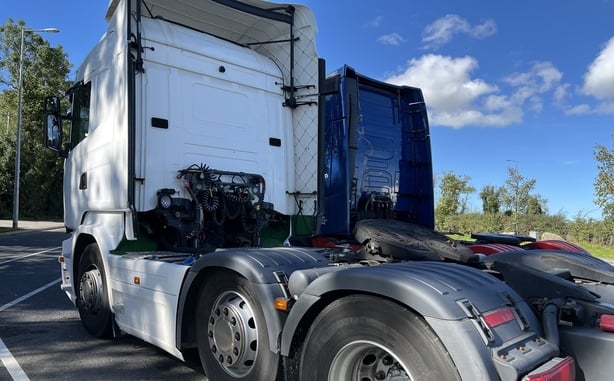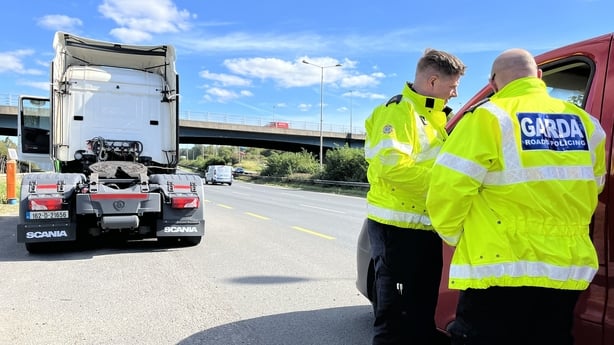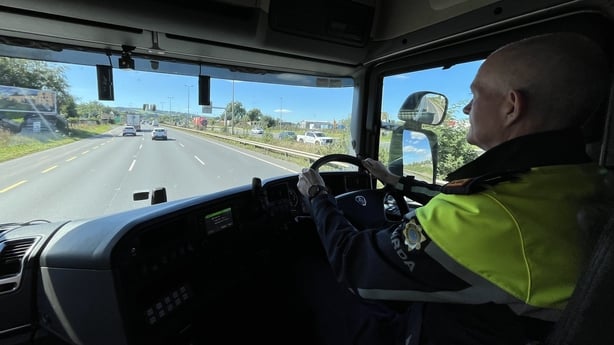New garda lorry cab helps to detect more traffic offences
A lorry cab used by gardaí to clamp down on dangerous driving has already helped detect more than 100 driving offences since its introduction last month.
The heavy goods vehicle tractor cab was purchased by An Garda Síochána as part of efforts to target distracted and careless driving, as well as seatbelt use by HGV drivers.
The new road safety initiative was deployed in August under Operation Iompar to assist with tackling inappropriate behaviour by people behind the wheel.
The unmarked lorry cab, which has had its speed limiter removed and is equipped with blue flashing lights, is driven by a trained garda.
It will be in use on the country's dual-carriageway and motorway network.
A second observer garda uses the elevated position to see down into cars and vans, while the higher vantage point also allows the officer to look into other HGV cabs.
The garda lorry cab is accompanied on patrols by either a garda patrol car or an unmarked garda car known as the interceptor vehicle, which follows a short distance behind.
If any offences are detected, the information is relayed to the interceptor car and the offending drivers are pulled over by the gardaí.
 The lorry cab will be in use on dual-carriageways and motorways
The lorry cab will be in use on dual-carriageways and motorways
To date, dozens of motorists have been issued penalty points and fines for a range of driving offences, in particular mobile phone use and the non-wearing of seatbelts.
During a 45-minute period yesterday alone, two drivers were spotted by gardaí in the lorry breaking the rules of the road.
One van driver, who was seen texting while driving on the eastbound carriageway of the N7 at Citywest in Dublin, was stopped and issued with a Fixed Charge Notice.
Garda Des Griffin from the Garda Roads Policing Unit was on the observer duty in the cab.
"We drove passed him, I looked out and his phone was on his leg and he was reading a text or texting at the same time, and he was looking up and down while driving, so he could not observe the road or anyone around him, and he could have caused a crash."
Gda Griffin said it would have been harder to detect the mobile phone resting on the driver’s leg from a standard patrol car.
 Gardaí detected the driver of a van using his phone while driving
Gardaí detected the driver of a van using his phone while driving
"You might have picked it up if you were driving a jeep or if you were on a motorbike, you might have been able to look in, but otherwise you wouldn't have seen it if it wasn't for the truck."
A short time later, another van driver was spotted from the lorry cab on the M50 in Dublin with his phone in his right hand texting and a carton of milk in his left hand.
He was also pulled over by the interceptor car and issued with a Fixed Charge Notice.
A similar system has been in use in the UK since 2015, but British police use cameras to record the driving offences being committed.
HGV cabs are also widely used by police across the European Union.
Inspector Peter Woods, from the Dublin Metropolitan Regional Roads Policing Division at Dublin Castle, said the idea of using a truck to enhance the enforcement ability of gardaí has been in the planning stages for some time.
"Essentially, the concept is quite straightforward. The elevated position in the cab of the tractor unit allows us to see into all forms of other transport on the road, other trucks and high sided vehicles."
 Inspector Peter Woods said significant detections have been made since the initiative was launched
Inspector Peter Woods said significant detections have been made since the initiative was launched
"We can see down into cars and see motorists committing offences like holding the mobile phones, not wearing a seat belt, using a laptop or a tablet or anything else that could contribute to distracted driving and potentially result in serious injury or fatal road traffic collisions," he added.
Inspector Woods described the newly adopted tactic as "another tool in our belt to enhance our enforcement capability and hopefully make the roads a safer place for everyone".
He said "significant detections" have been made since the initiative was launched last month.
"We've done four or five days so far. On each of those dates, we've had about 30 to 35 offences detected."
"Unfortunately, we're getting a lot of things like mobile phone use, not wearing seat belts, people watching football matches on tablets or laptops when they're sitting in heavy traffic, anything like that, that can cause distracted driving and result in a traffic collision is what we want to stop," he added.
As part of the pilot project, one HGV is currently in use, which will be rolled out on operations nationwide over the coming months.
Inspector Woods said: "Hopefully, based on the success we're having to date, we'll have another couple of vehicles to be deployed around the country in the future."
New garda figures showed that so far this year over 15,000 people have been detected using their phone while driving.
The number is almost 2,000 more than during the same period in 2023.
An Garda Síochána also said 421 drivers received a fine and penalty points on their licence last month alone for using their phone behind the wheel.